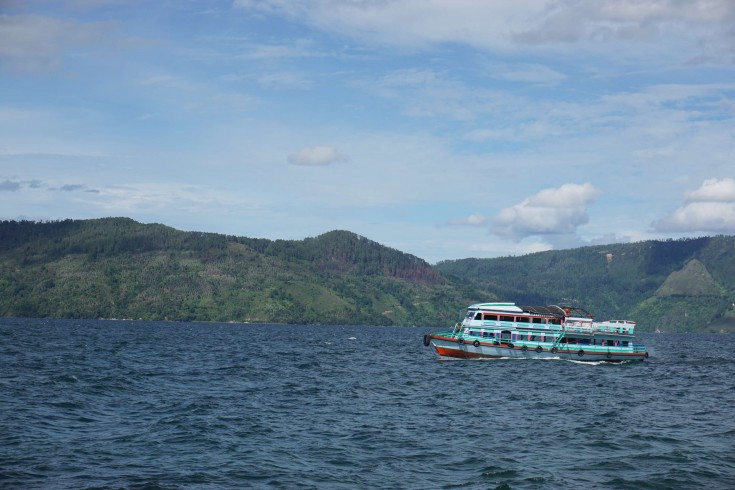

Just breathtaking
Published/Last edited on 4th June, 2019.
Lake Toba (Danau Toba in Indonesian) is the largest volcanic lake in the world, formed by a cataclysmic eruption around 70,000 years ago which saw ashfalls as far away as eastern Africa. That eruption shrouded the earth in a blanket of ash for years and led to the cooling of the planet. Today, the lake is a calm, picturesque body of water surrounded by towering mountains and a favourite resting place on the Sumatra backpacker circuit.
In three words? To chill out. After Sumatra’s somewhat rough and ready transportation, putting your heels up while overlooking the waters of the lake (or swimming in them) is an ideal way to recharge—people come planning a day or three and end up staying for a week or three. Prepare your itinerary accordingly.
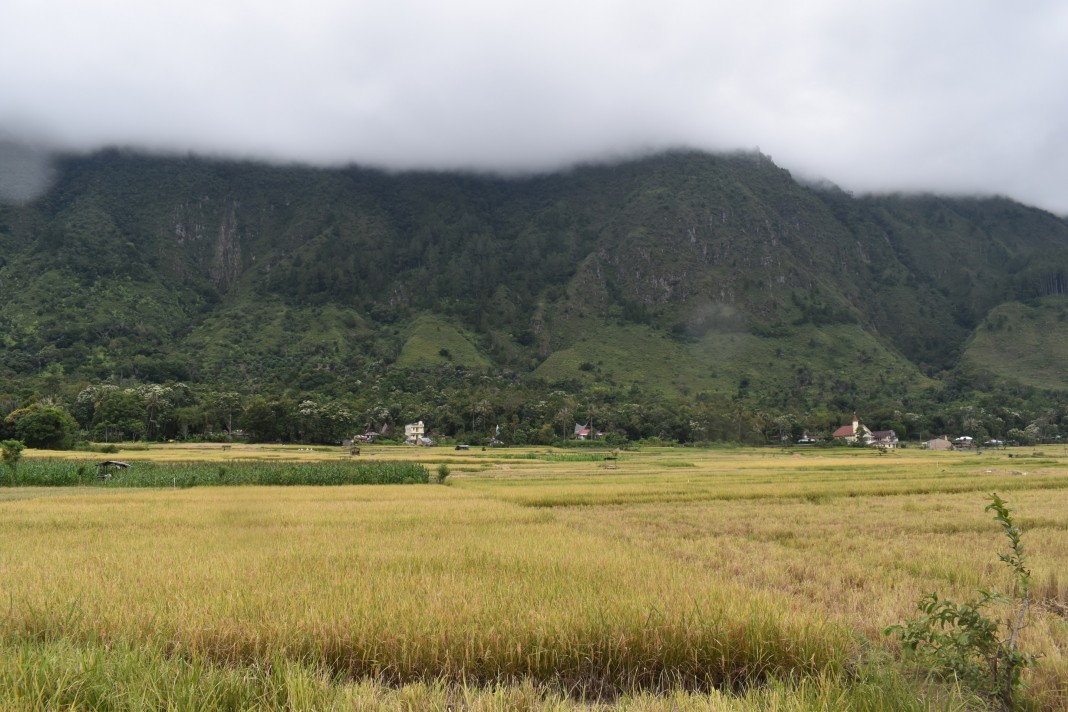
Towards the centre of Lake Toba lies Samosir Island (Pulau Samosir), where almost all foreign visitors choose to stay. Pulau Samosir is 44 kilometres long and 20 kilometres wide, making it one of the largest lake islands in the world. Running along the centre of the island is an escarpment that comes to life after rain with waterfalls and swirling heavy clouds, all visible from the lakeside town of Tuk-Tuk.
While the primary attraction is relaxation, the lake, Samorsir island and the surrounds offer breathtaking scenery which can easily be explored and appreciated by hired scooter or car. The interior of Samosir holds a number of waterfalls and the tourist hub of Tuk-Tuk offers plenty of distractions to keep you busy. Home to the Toba Batak people, there are also a few minor museums and historical attractions which may be of interest. But for many, the primary attraction is simply the sheer beauty of the place. The sunsets can be magnificent.
As with Berastagi, Medan and Bukit Lawang, Lake Toba shares the same weather system as the rest of this part of Sumatra—wet between November and March and less wet the rest of the year. Visiting in April, we had heavy rain most afternoons, but the mornings enjoyed plentiful sunshine and bright blue skies. Over most weekends Lake Toba attracts a steady trade of domestic tourists who will outnumber foreign tourists in all but peak season. This is also the only time you are likely to need a reservation—if even then.
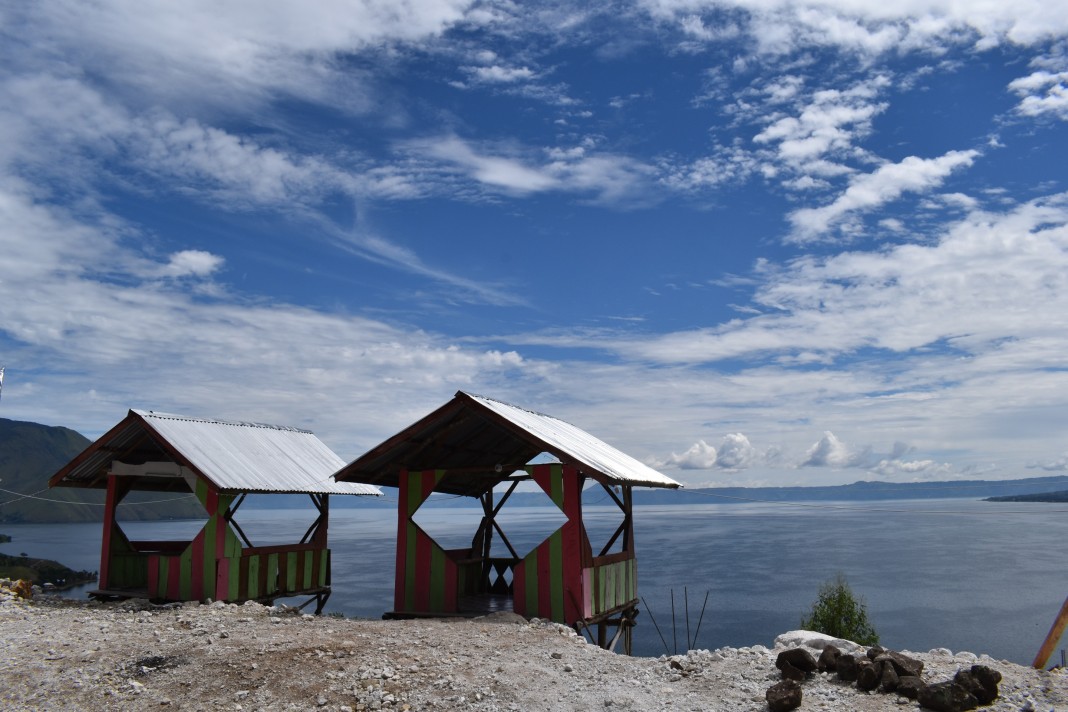
As with all of North Sumatra, the foreign tourist trade is extremely seasonal. Outside of the June, July and August European summer period, the number of foreign tourists on the island is extremely low. In wet season, even more so. The July August period is most likely the only time having a booking in advance will really be prudent.
Tuk-Tuk is by far the most popular tourist destination on the island and is home to dozens upon dozens of budget accommodation options, mainly due to the immense popularity of the island during the late 80s right through until the late 90s, when a combination of political upheaval in Indonesia and the introduction of a shorter tourist visa rules smashed local tourism—foreign visitor numbers have never really recovered from this period.
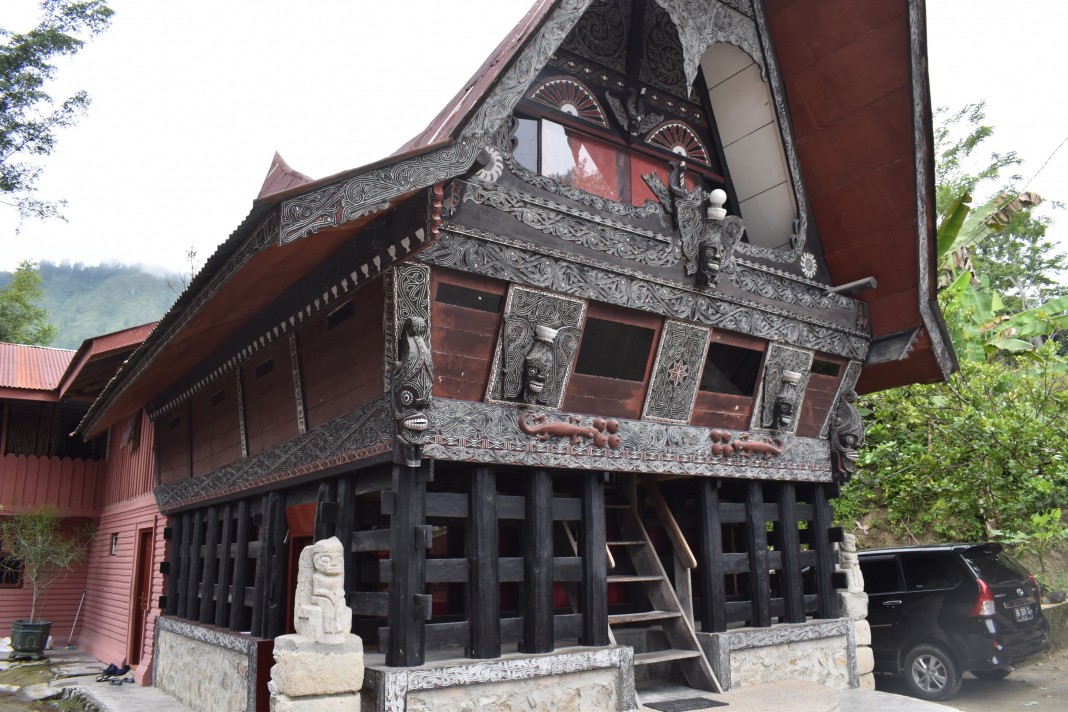
Tuk-Tuk is on the east coast of Pulau Samosir, roughly across the lake from Parapat, the main ferry port on the mainland. On the west side of Pulau Samosir is the town of Pangururan, another transport hub for those wishing to try their luck along the remote west coast of Sumatra. The interior of Pulau Samosir is sparsely populated and ripe for exploration by scooter.
A ring road circles the island and these days it is in good condition for almost the entire way, meaning it is possible to circumnavigate the island in a single full day.
Facilities on the island aren’t all that developed and you’ll probably never see the police, but a small health clinic in the middle of Tuk-Tuk can patch up cuts and bruises. If you’re seriously ill, the nearest hospital is in Kabanjahe, roughly three to four hours hours away. For anything serious, head to Medan.

The tourist office is in Tuk-Tuk, but unless your primary point of visiting is to sign in their guest book, have have little to offer save a couple of general maps.
In June 2018 a local ferry, the MV Sinar Bangun, sunk in stormy conditions resulting in the deaths of almost 200 Indonesians. The boat was severely overloaded (with both people and motorbikes) and save the life jackets you’ll see crammed under the seats, few safety changes have been made to how the boats operate. If your ferry looks overloaded, do not get on. Wait for the next ferry.
Tuk-Tuk on Pulau Samosir is the main accommodation area for foreigners visiting Lake Toba. This is the place with the the largest selection of restaurants and the most relaxing accommodation options. When you are on the ferry from Parapat tell them where you are staying and they’ll drop you there as just about every spot has a boat landing of some description.
Tabo Cottages
# Tuk-Tuk
T: (0625) 451 318
info@tabocottages.com
http://www.tabocottages.com
If you’re looking for a family-friendly midrange option in Tuk-Tuk, Tabo Cottages is easily the pick of the bunch with oversized rooms, sprawling lawn grounds and a good sized swimming pool with over-water views.
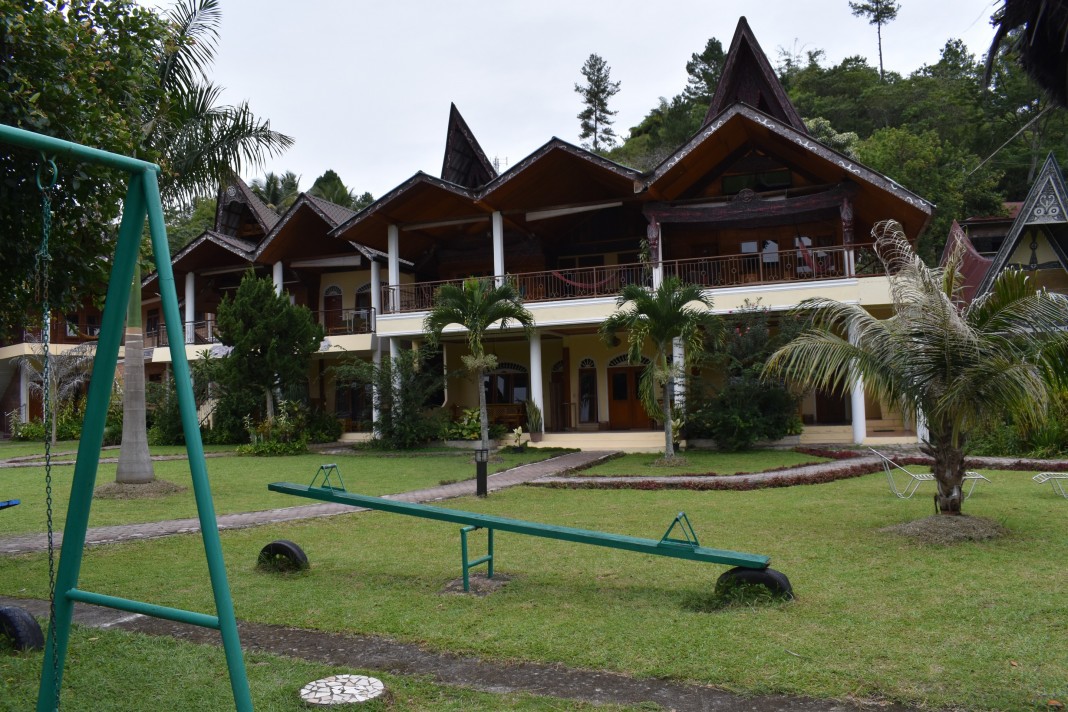
Rooms are in a few two-level complexes scattered across the grounds and we’d imagine most would have at least a partial view. While not as modern as Zoe’s within, the fit out is solid and a lot of effort has been made with the oversized hot water bathrooms—probably the best we saw on Toba (note: low base!).
The grounds include a few nods to kids, including a swing set, but even just the lawn grounds is enough to keep kids busy. Toba also has a swimming pool towards the edge of the lake, again good for kids and for those not interested in swimming in the lake.
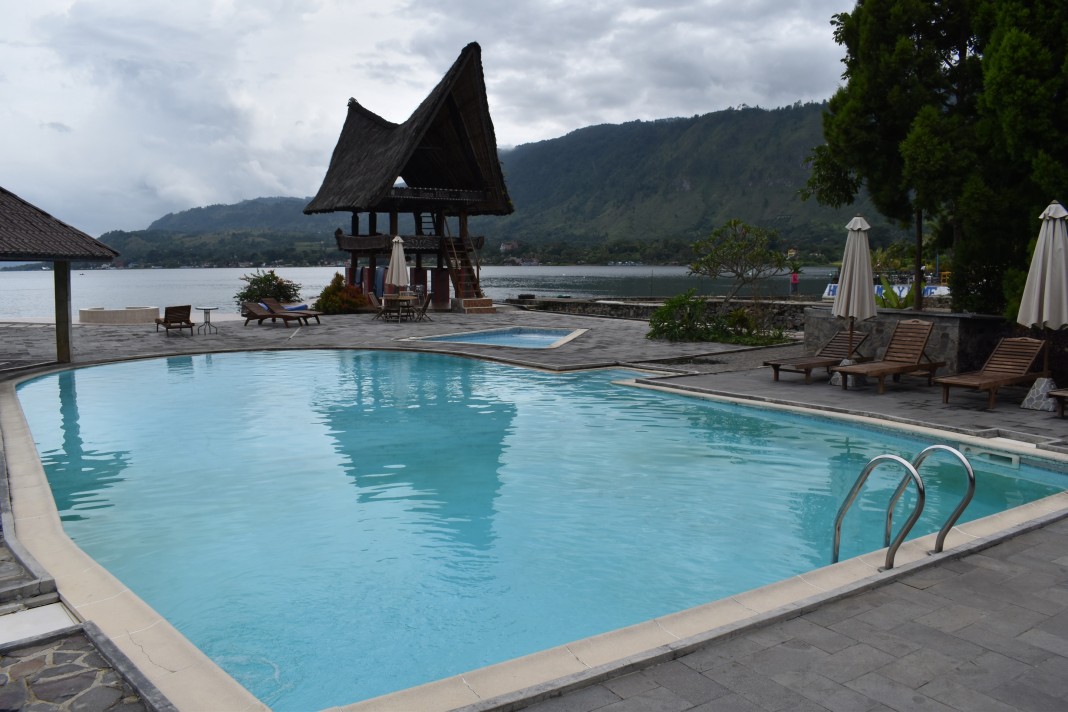
While we didn’t eat there, the restaurant gets good reports. Staff are professional and happily showed us around the property. Overall this is a solid option for families with a more comfortable travelling budget. Recommended.
Gokhon Guesthouse
# Tuk-Tuk
T: (0852) 6169 1642
https://www.facebook.com/pages/category/Hotel-Resort/Gokhon-Guesthouse-345065818989127/
One of a bunch of similar properties in a row facing directly onto the water, Gokhon Guesthouse steps above the crowd with bend over backwards friendliness and very clean and well kept rooms.

Rooms are well sized but simple—fan-cooled affairs with TV, IKEA style furniture, reliable WiFi, a bouncy bed and scaldingly hot water in the clean bathroom. Each room has its own terrace looking out to the lake—go for an upstairs room for more privacy and an even better outlook, though those with kids may prefer a ground floor room as the terrace opens straight onto the lawn.
The lawn runs down to the waterfront where there are a couple of salas to escape the heat of the day in. While we didn’t swim here, other guests did and lazed around on the lawn afterwards. This is a family-friendly option and is also close to a few restaurants and bars.
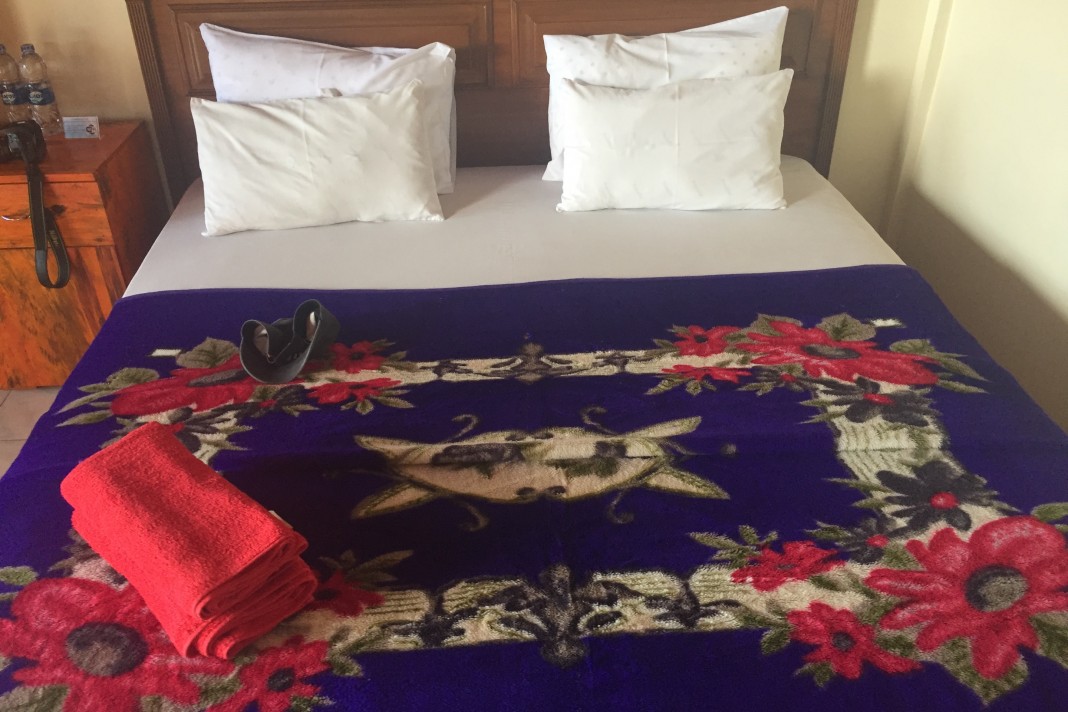
Reception has a small book swap available—don’t see many of those these days! The friendly staff can also assist with onwards travel plans, and the scooter we hired from here was in very good condition. For the standard, the rates (starting at 250,000 rupiah) are perhaps a smidgen high, but they’ll tumble down for a longer stay. Recommended.
Romlan
# Tuk-Tuk
T: (0811) 654 7735
romlantuktuk@yahoo.com
http://www.romlantuktuk.com
Long running backpacker haunt Romlan can be quite a struggle to find from the street as, as far as we could see, there is no street signage, but it is worth making the effort (take the driveway after Maroan Reception and you’ll see the Romlan name painted on the wall).
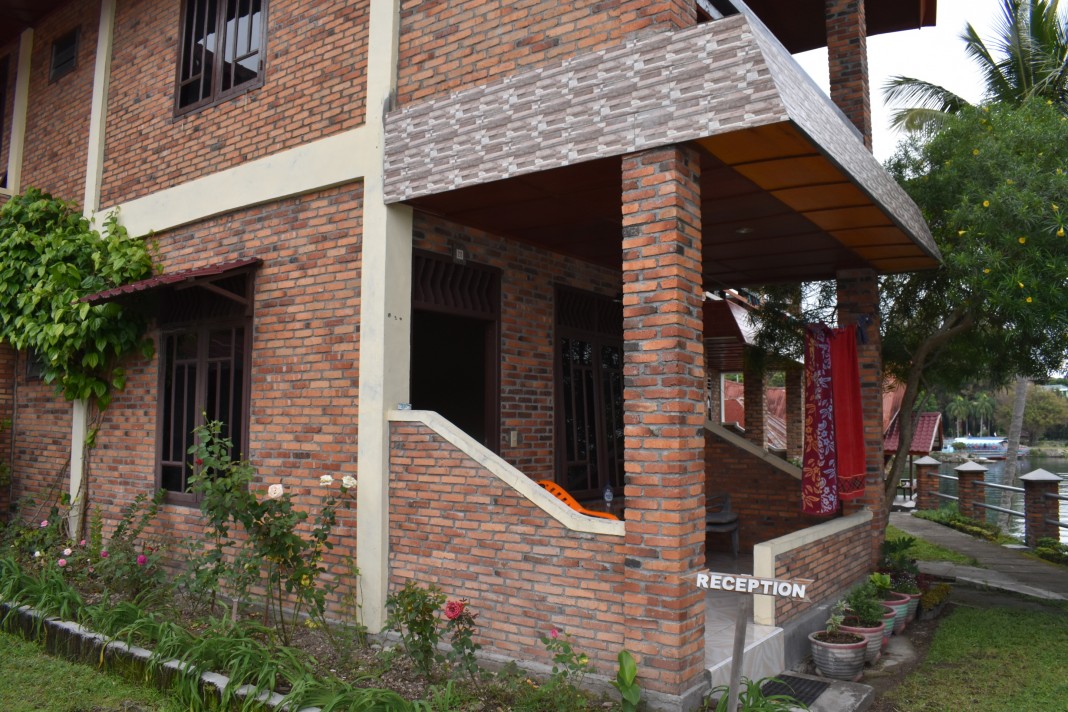
Offerings here include very well-priced rooms in two floor brick and concrete blocks—definitely go for an upstairs room for a better outlook and more privacy. A traditional house is on hand for those with a more comfortable budget.
Grounds are well kept, and while the waterfront area is a large concrete platform it is well designed and includes a large shade tree to help you escape the heat and enjoy the cooling breeze (if there is any) off the water.
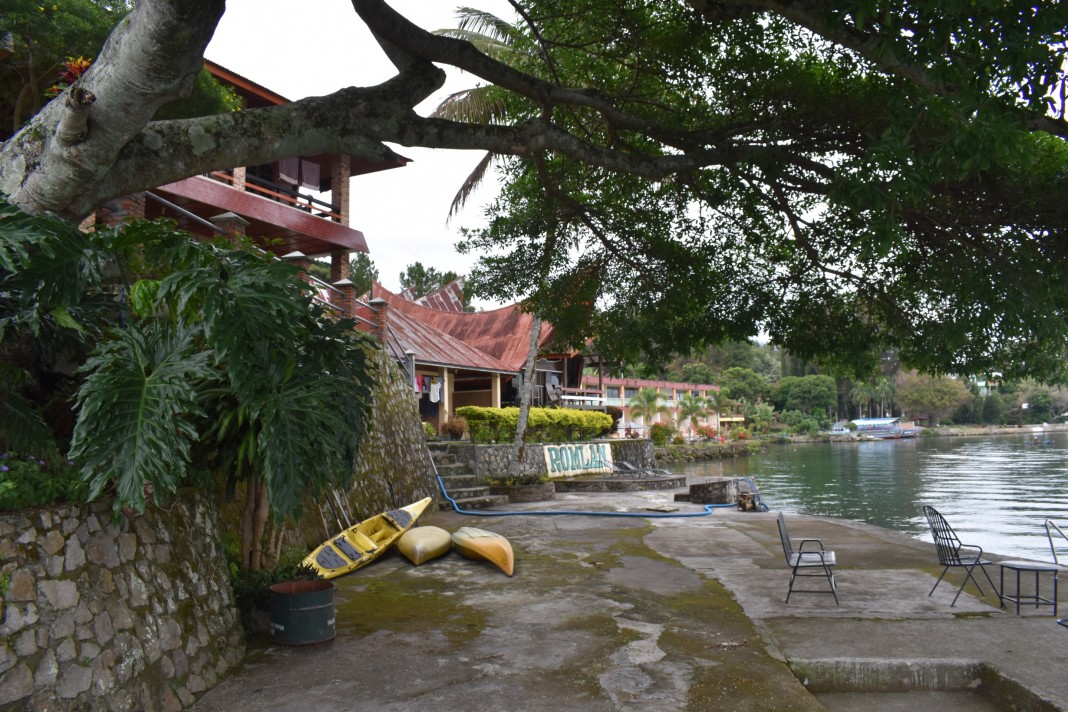
Staff were professional and friendly. Romlan has been in the guidebooks for years and in season fills fast, so reservations in advance are a good idea in season. Rates started at 175,000 with hot water which struck us as very good value.
Zoe’s Paradise
# West side of Tuk-Tuk
T: (0812) 6315 2955
info@zoesparadise.com
https://www.zoesparadise.com/
The smart multi-storey Zoe’s Paradise is about as modern and flash as the accommodation scene gets on Lake Toba and if you are after sharp white linen and towels contorted into swans, then you are in the right place.
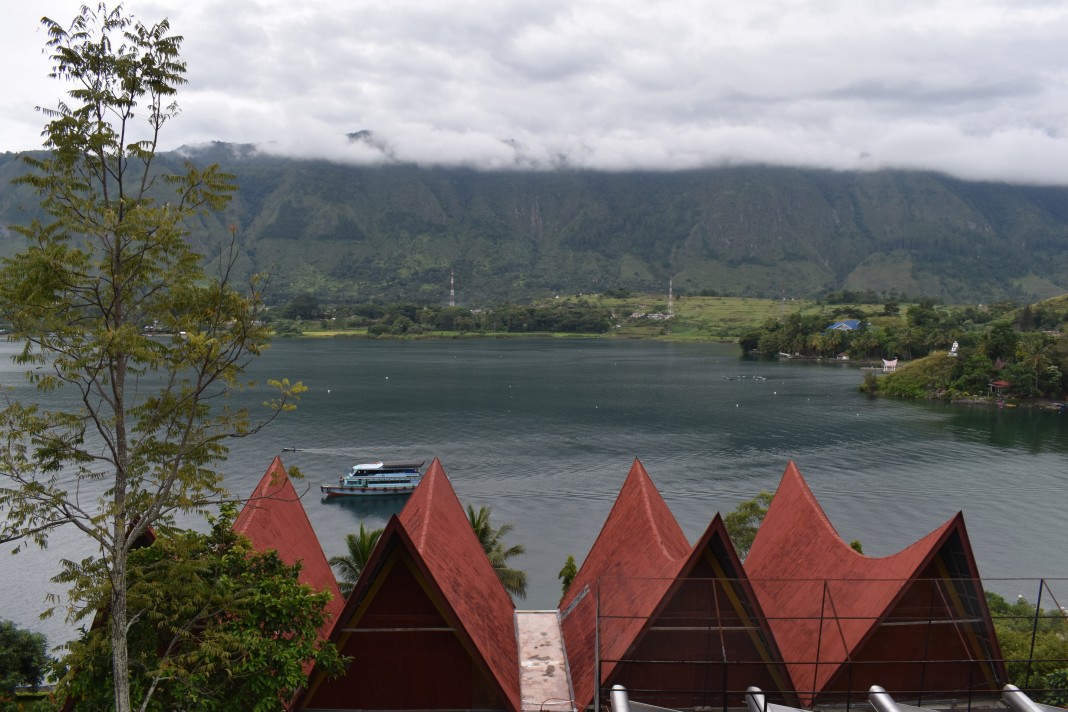
Rooms are well sized and very clean, with modern bathrooms and the bed comfortable. Views can be good, but some views are somewhat obscured by the roofs of the rooms on the floor below. Zoe’s also has a good restaurant area and a moderately sized swimming pool should the lake water not be appealing.
As there are not all that many hotels of this standard and style in Tuk-Tuk, this one does fill up, especially on weekends—book in advance. The grounds are compact and there are a lot of stairs to get down to the pool level—do watch your step on the slippery stair tiles with wet feet. Low season rates start at 549,000 for an economy room, 669,000 for a superior and 799,000 for a deluxe. Peak season rates are extremely high for the standard—shop online for a discounted rate.
Judita Cottage
# East side of Tuk-Tuk.
T: (0813) 7608 5239
A little to the north of Gokhon, Judita Cottage is a good option if you want a slightly better fitted out and larger room, or a designed for families room.

On the down side, there is no lawn area, instead a concrete terrace runs down to the water, where there is a small diving board. The top floor rooms are family rooms making this worthy of consideration for those with kids in tow. Beds are comfy with above standard (for Toba!) linen and the bathroom in the room we were shown was immaculate. Judita is closer to the handful of bars in this area so you may get a little more noise in the evening. We preferred the nearby Gokhon, but either is reasonable for this price bracket. Standard doubles go for 250,000 rupiah.
Bamboo Guesthouse
# North coast of Tuk-Tuk.
Better known for the ideally placed sunset bar and restaurant (even if you are not staying here do swing by for at least one sunset), Bamboo Guesthouse also has three rooms hidden away below the restaurant by the water’s edge.
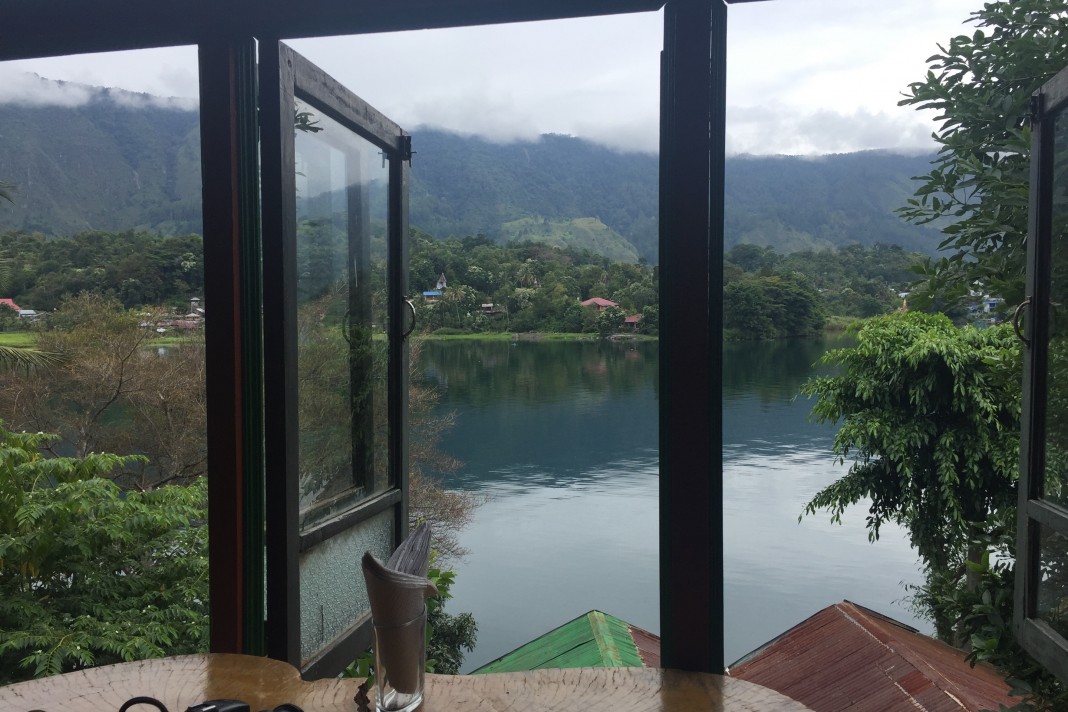
One is a large wooden bungalow, the other two concrete blocks. For a budget traveller comfortable with a wooden shack and a very basic cold water bathroom, we thought the wooden bungalow was pretty appealing (though we wouldn’t bother with the other rooms). The price, at 100,000 rupiah, was also good value.
The bungalow has a wood and rattan structure, lino floor and a very very old mosquito net—think a budget 1990s Thai bungalow on the lake and you’ll have the right idea. For budgeteers only.

The real attraction here though are the terrific views from the upstairs cafe and restaurant. Plenty of comfortable seating, including a very tempting daybed, make this a great spot to idle away a day or enjoy the sunset from.
Abadi Guesthouse
# North coast of Tuk-Tuk.
T: (0813) 7507 9580
abadi.guesthouse@gmail.com
http://abadi-guesthouse.blogspot.com/
Just down the ridge from Bamboo, we thought Abadi was abandoned when we first arrived, but we eventually found a staffer who, to be honest, seemed very surprised we wanted a room.
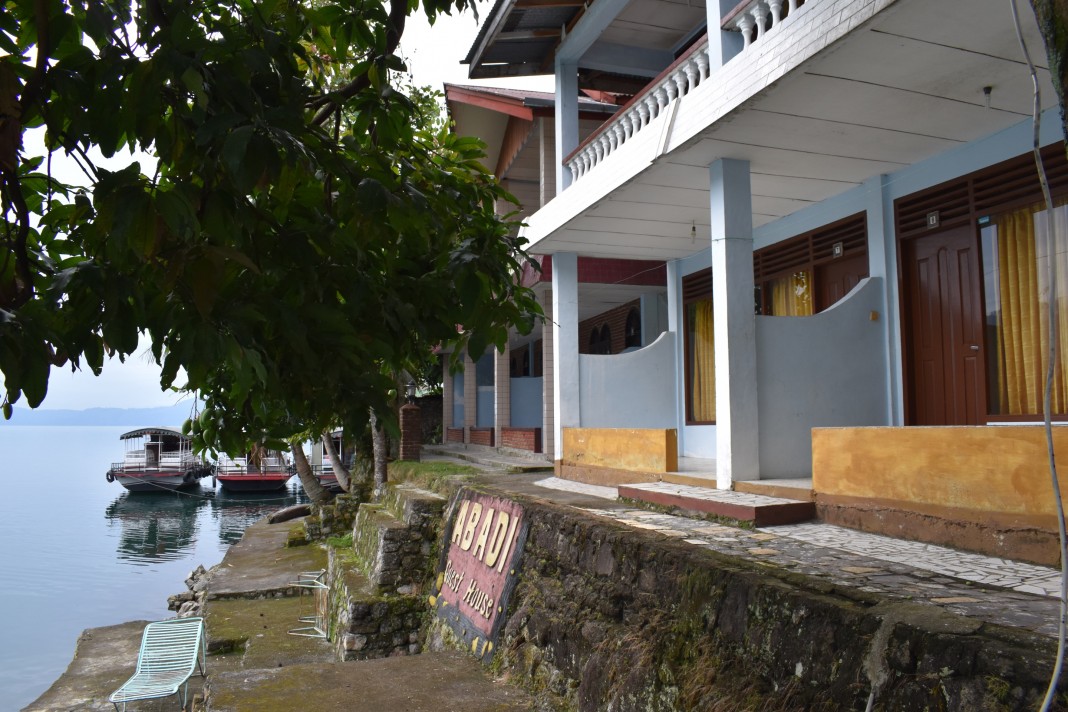
Set in a couple of two floor, brick and concrete longhouses, the rooms are of a decent size with real beds which we were very surprised to see, but the bathroom was not good and needed a very serious scrub. These points aside, the waterfront location is terrific and there is a large mango tree overhanging the water you can probably swipe a mango from in season.
Given the size of the rooms we thought we misheard the rates when we were first told, but 100,000 rupiah, which quickly dropped to 80,000 rupiah was sound value for the standard. Consider here if you don’t mind peeling paint and a decent load of grime, but really want a terrific sunset view. Note travellers with young kids may want to opt for an upstairs room as the ground floor rooms have a two level unfenced drop into the water.

Click on the hotel name to open its position in Apple or Google maps.
It would be fair to say that Lake Toba is on the tourist trail more for the scenery than the culinary scene, but there are no shortage of spots to fill your stomach after a day lazing by the water’s edge or scootering around the island.
As most of the accommodation is clustered around Tuk-Tuk that is where you will also find the highest concentration of places to eat. There is often little to differentiate places, with many offering Indonesian standards along with a broad mix of standard western dishes—don’t be surprised if staff dash off to buy ingredients after you order. If you’re after better standard local fare and have your own transport, consider nipping south along the coast to Tomok where you’ll find local restaurants. Also on the far (west) side of the island in Pangururan there are plenty of local eateries, but it is a long way to ride for a meal.
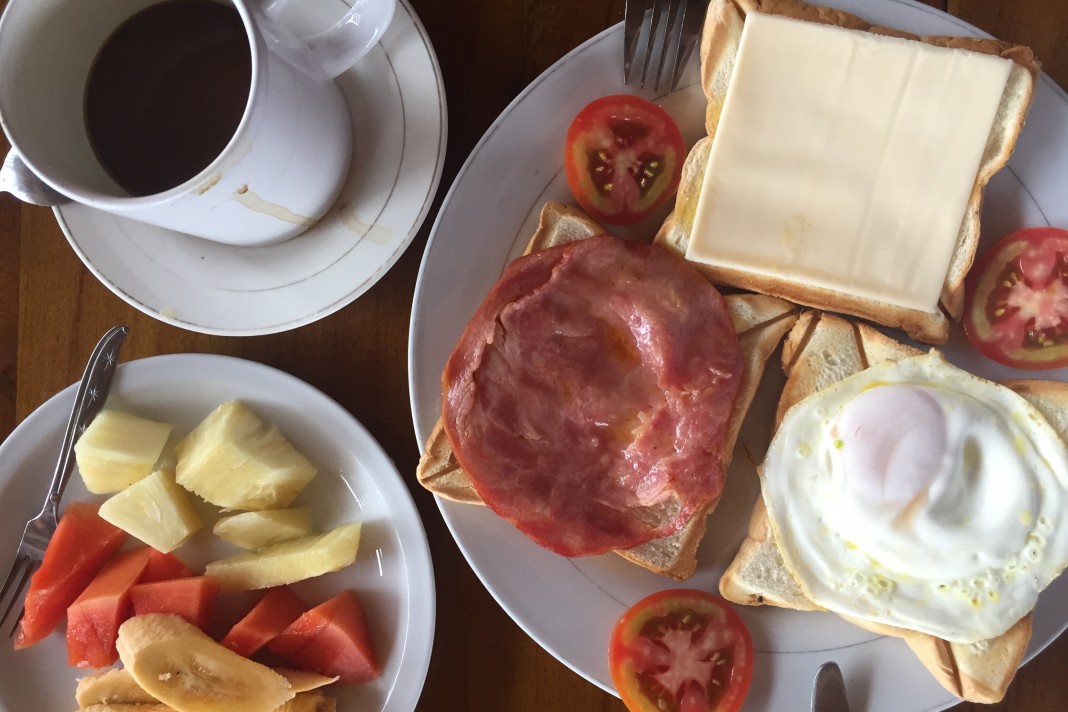
While some guesthouses do include breakfast, many don’t and we found ourselves at Orari on a couple of occasions. The Western style breakfast is huge, the coffee piping hot and the water views are amongst the best for a restaurant along this stretch of Tuk-Tuk. Especially friendly and welcoming staff make this an all round good option for breakfast.
If you’re over the other side of Tuk-Tuk, while we didn’t try it ourselves, the breakfast at Tabo Cottages gets consistently good reviews, so consider there if you are over that way and need some baked goods and coffee.
We like our pork and a barbecue dinner at Alyssa Restaurant ticked a lot of boxes. The meal was, well barbecue pork (65,000 rupiah), and a lot of it. A single portion should be more than enough for two people, especially if you get it with a side of rice or another dish. Friendly staff and this place gets busy in the evening (by Tuk-Tuk standards), which gives it a slightly more festive feel than most of the establishments on the island. Other BBQ fare is available and the beers icy cold.

Remaining with the pork theme for a moment, Maruba’s doesn’t look like much from the street, but it is notable for a few traditional Batak dishes they offer. We tried the Sangsang (85,000 rupiah)—a Batak wedding dish—which was large chunks of porks stewed in spice and pigs blood. Two thoughts: It is rich and you need not have eaten for the previous part of the day as it is a very filling meal, or plenty enough for two.
If you want to stick with Indonesian, RM Islam Mami Tempo is a small Halal establishment on the east part of Tuk-Tuk (overlooking the road, not the water). They offer standard Indonesian fare (we went with the ayam pangsit), and the prices very reasonable. This is well situated for many of the accommodation options, so makes for an easy meal. Just along the road from here is a small popular bar—a good option for a cold drink to wash it all down.
Long running Jenny’s is a hop skip and a jump from Mami Tempo’s and is worth dropping by for a dinner of delicious grilled fish (71,500 rupiah). Watch your table though—we popped out for a phone call and returned to see a cat digging into our dinner. Friendly and cheap.
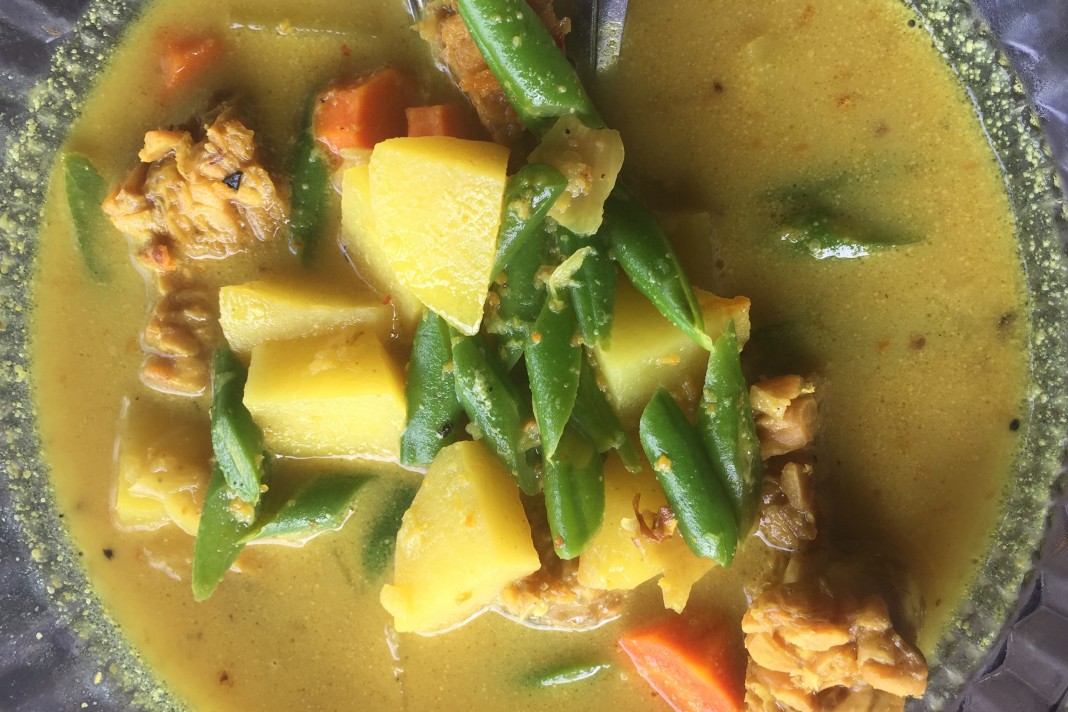
When it comes to sundowners, two places spring to mind, both ideally situated on the north coast of Tuk-Tuk. Bamboo Cafe offers the more comfortable and homely setting (and an excellent music selection) with comfy seating and a daybed ideally positioned to take in the late afternoon rays. Right nextdoor, Reggae lacks the comfort, but the views are just as good. Do make sure you swing by one of these two spots for at least one sunset—the views are just lovely. Both also have rooms available.

Click on the restaurant name to open its position in Apple or Google maps.
Alyssa Restaurant Near Tabo Cottages, Tuk-Tuk.
Bamboo Cafe Near Abadi Guesthouse, north coast of Tuk-Tuk.
Jenny’s Restaurant Near Samosir Cottages, Tuk-Tuk. T: (0813) 9791 4229 https://jennysrestaurant-restaurant.business.site/
Maruba’s Restaurant West side of Tuk-Tuk, near Marco Polo.
Orari Restaurant Near Samosir Cottages, Tuk-Tuk. T: (0813) 9697 4343 https://orari-restaurant.business.site/
Reggae Guesthouse and Restaurant Near Abadi Guesthouse, north coast of Tuk-Tuk.
RM Islam Mami Tempo Near Samosir Cottages, Tuk-Tuk. T: (0813) 9716 7309
Tabo Cottages South side of Tuk-Tuk. T: (0625) 451 318 http://tabocottages.com
Chatting to a couple of foreigners at our guesthouse in Tuk-Tuk, we asked how long were they staying and they replied “three months”—Lake Toba is that kind of place. While yes, you too could spend three months watching the water glisten, you really only need a couple of days to take in the primary attractions which the island offers.
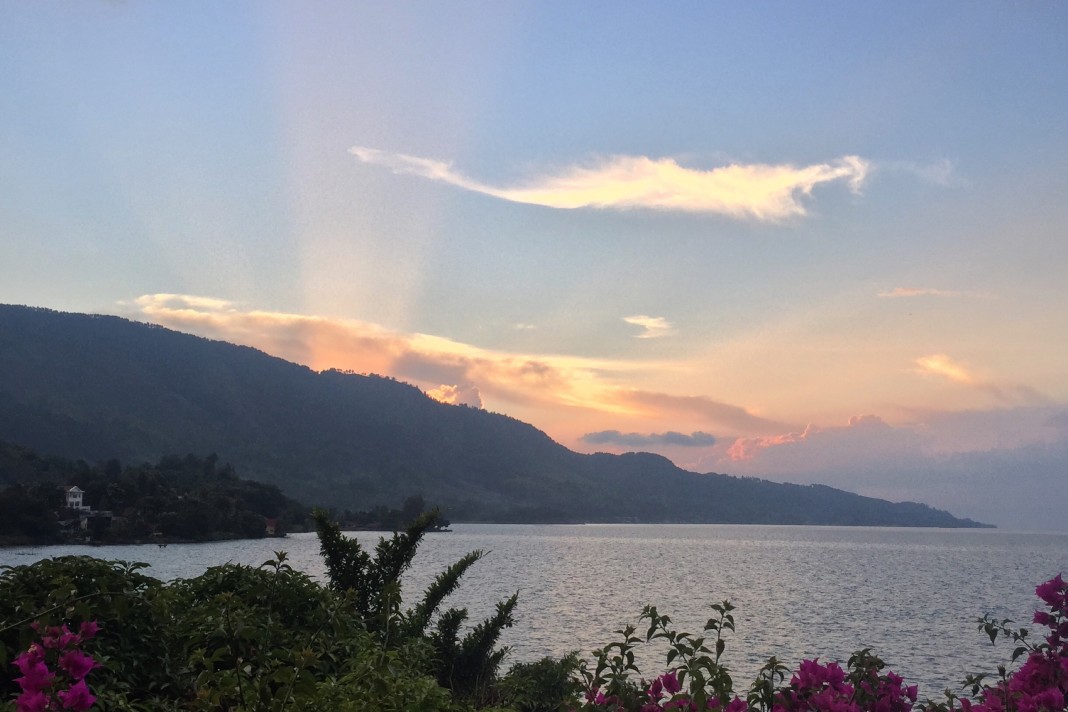
At some 100km in length, 30km in width and (in places) some 500m deep, the lake itself, the caldera of a still active volcano, is one of the most jaw-dropping sights in North Sumatra and one of the best ways to appreciate it is by hired scooter or car. The roads are in a very good state (by Indonesian standards), the traffic light and there are no shortage of viewpoints from where you can better enjoy the sheer beauty of the island and the surrounding lake.
The other primary claim to fame are a series of small museums and “ancient sites” along with traditional dance shows performed for tourists at set times through the days. We visited a couple of the museums and would say if you’re interested in Batak heritage you would be far better served by a visit to the Museum of North Sumatra in Medan or the Museum Pasaka Karo in Berastagi as both are far better curated and presented collections with clear labelling in English. On Toba expect dusty collections poked into dusty traditional houses, often confusingly labelled or simply not labelled at all—what you won’t miss however is the admission charge to most of them.

Of the museums, the two most commonly visited are Museum Huta Bolon Simanindo near the northern tip of the island and the Batak Museum in Tomok (a few kilometres to the south of Tuk-Tuk). Traditional dance can be seen at both, at the former at 10:30 and 11:45 Monday to Saturday and 11:45 on Sunday—if you’re in the area at the time, pop in for the performance.
Other minor points of interest include the “Stone Chair of King Siallagan”, a supposedly ancient collection of stone chairs (allow five minutes) in Ambarita village slightly to the north of Tuk-Tuk and the tomb of King Sidabutar, a Batak king who converted to Christianity, in Tomok (on the way to the Batak Museum, so knock them both off on the same trip). According to local lore, the latter was constructed about 300 years ago, and the chairs are said to have been used by a king’s council to determine the fate of captured enemies and criminals. If a person was sentenced to death, they could be slaughtered on a nearby stone table and then cooked up to be eaten by said council.

The real attraction to exploring Samosir Island however, is the great outdoors, and, with your own transport, you can take in the museums and the ancient stone chairs and a whole lot more—and don’t limit yourself to the island—the “mainland” to the west offers more spectacular viewpoints, some hot springs and waterfalls. Lets go.
One thing you may notice as you explore the island is ornate buildings dotted in random spots in the countryside—these are Batak graves. The graves can range from very humble affairs to the grandiose and you’ll see them not only on Samosir but right across North Sumatra, wherever Batak people live. Explore, photograph and visit with respect please.

Leaving after breakfast, head north from Tuk-Tuk (slow down for the Stone Chair of King Siallagan) and continue north along the eastern coast of the island. The water runs out to your right and the escarpment which dominates the interior to your left—in season beautiful rice fields ripple in the breeze. Eventually you’ll reach Simanindo, where, if you time it right, you can stop for a traditional dance performance at Museum Huta Bolon Simanindo. Continue north, rounding the top of the island and start rolling down the west coast.
Along the way you’ll pass Situnkir Beach and White Sand Beach, neither of which are really crowd-stoppers, but in the late afternoon, with the setting sun, are popular with the Instagram set (yes there are Insta-props waiting for you). Follow the road south and you’ll be on the northern outskirts of Pangururan, the biggest town on the island, but don’t enter the town, instead take a right over the causeway (OMG Samosir is not really an island!) onto the mainland.

After the causeway, take the right which is signposted for a series of hot springs (air panas). You’ll know when you reach them, as a cluster of buildings and hotels have been built there which pipe the hot water in for their guests. Have a soak if that is your kind of thing. We’re more viewpoint kind of people though, and instead would suggest you ride on. Along the way you’ll need to climb a series of hairpins, so take care (though traffic is close to nonexistent) and you’ll also pass a few small cafes and warungs that take advantage of the view. Keep going and you’ll spy on your right a spur of land jutting out into the water with a tin roofed house on it. Keep a sharp eye out for a dirt trail running off to your right, follow it and enjoy the absolutely gobsmacking viewpoint from here—on a clear day you can see Gunung Sinabung near Berastagi! The viewpoint is marked as “Bukit Burung” on some online maps.
Once you pick your jaw off the ground, backtrack past the hotsprings to the mainroad and turn right. Just keep going and you’ll eventually reach a signposted turn-off to your left to Efrata Waterfall and just follow the signs. This road also has its fair share of switchbacks (watch out for trucks) and the last stretch of road is a little patchy. The waterfall is pretty and powerful and well worth the thirty minutes or so it takes to reach by scooter from Pangururan.

From here, return to Pangururan and grab a local bite to eat, then make a decision: either continue south to circumnavigate the island, or make it a halfway loop and go over the top—we went with the latter. The road started off a bit scrappy, but improves as you rise up the escarpment and on to the plateau—just keep going! On your left you’ll pass Lake Sidihoni—one of a few lakes that are popular spots for afternoon photos with bench seats ideal for canoodling couples. This is after all a lake in an island in a lake in an island—not often you can say that.
After the lake, what traffic there is drops off to nothing and you’ll pass through a large eucalypt forest—it is great riding. Eventually you’ll start to see the lake waters again and the east coast of the island in the distance—there are plenty of viewpoints along the way and, as you wind your way back down, there are a few warungs where you can park your wheels and have another bite to eat or a cold drink and enjoy the fantastic views. The road will eventually deposit you a little to the south of Tomok, from where it is a clear run back to Tuk-Tuk.

You could do the above in as little as four or five hours, but slow down, enjoy the scenery and you could easily fill a day following this route. With another day, you could do the southern loop, and there are apparently other roads running north and south atop the escarpment but we didn’t have time to explore them first hand.
Motorbikes can be rented all over the shop in Tuk-Tuk and cost 100,000 rupiah per day. Please be sure to read the following page regarding the risks of riding unlicensed in Indonesia!

Click on the point of interest name to open its position in Apple or Google maps.
The closest airport to Lake Toba is Silangit situated to the south of the lake. The airport has domestic flight connections to both Jakarta and Medan and an on again off again international connection to Kuala Lumpur with AirAsia.
From the airport get a transfer to Balige (the closest town with a ferry connection to Samosir) or to Parapat (about two hours away by bus) from where there are more frequent ferries to Tuk-Tuk.
To get to Lake Toba, most people catch a ferry from the port town of Parapat, roughly four to five hours south of Medan. There are a number of ferry piers, you want to go to Tigaraja pier to get the boat to Tuk-Tuk. The ferry departs regularly throughout the day with the final departure being at 19:00—they’ll drop you at your hotel of choice (each one has a boat landing of some description). The ferry costs 15,000 rupiah per person and takes roughly 45 minutes depending on where you are being dropped off.
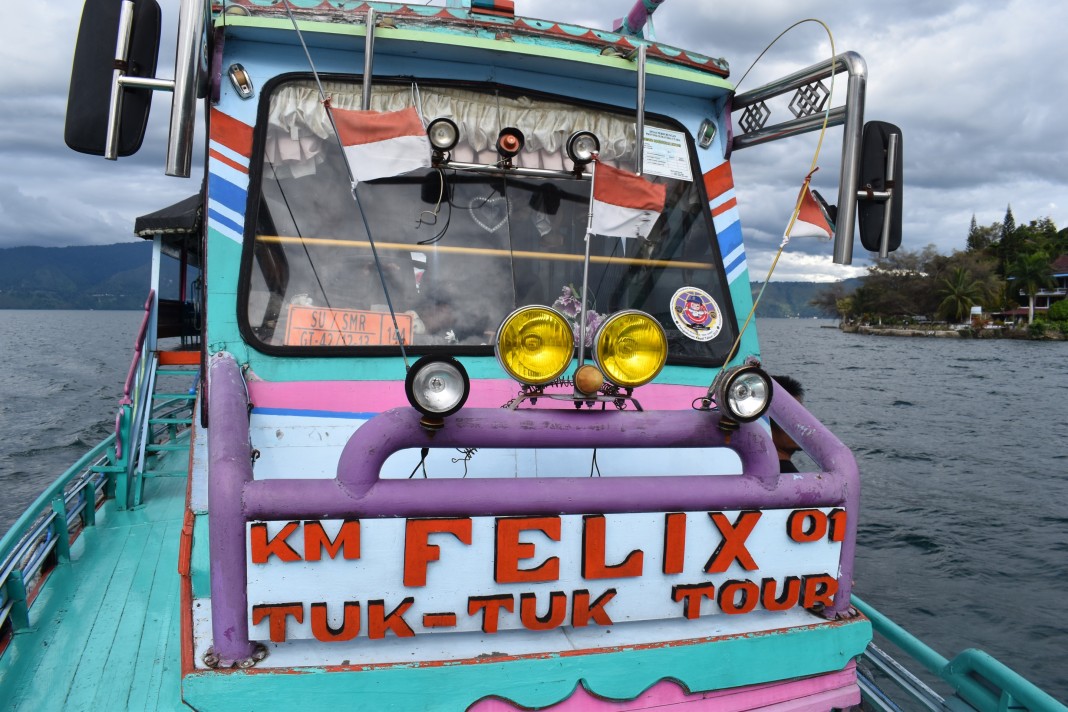
Leaving Lake Toba you need to get to Parapat first (by ferry), from where are a number of transport options. From the bus terminal, two kilometres east of the ferry port, buses take passengers to Medan, Bukittinggi and Berastagi (via Siantar). From the Parapat ferry port itself there are shared taxis charging around 80,000 to 100,000 rupiah for Medan (500,000-650,000 rupiah to charter an entire car) with direct connections to Bukit Lawang possible if there are enough foreigners wanting to share the same car. Sample fares include:
Bukittinggi: 16 hours, 350,000 rupiah, departs at 17:00 (note that prices from agents in Tuk-Tuk are negotiable and cheaper still from the bus station in Parapat but advance bookings are highly recommended as buses are coming from Medan and are often full)
Medan: 5 hours, 40,000 rupiah, regular departures
Siantar: 1.5 hours, 20,000 rupiah, regular departures
It is also possible to get to Berastagi, Sibolga and Ketambe from Pangururan on the opposite side of Samosir Island, but this requires an hour and a half long journey from Tuk-Tuk first and this added time often makes it more time consuming than just catching transport from Parapat.
By
Stuart McDonald.
Last updated on 4th June, 2019.
Banda Aceh
Berastagi
Bukit Lawang
Bukittinggi
Ketambe
Medan
Padang
Pulau Weh
Takengon
If you prefer to have all your ducks in a row before you hit the road, here are some travel services you may wish to consider.